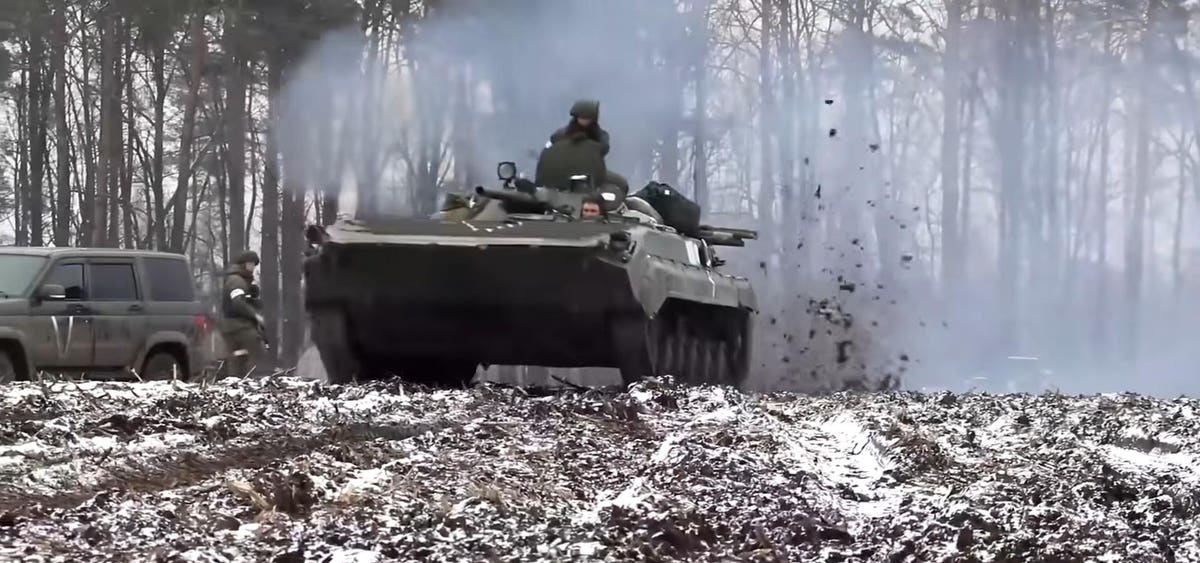The Russian army recently lost no fewer than 18 BMP-1 infantry fighting vehicles in just a day or few days of hard fighting, mostly in southern Ukraine.
The analysts at Oryx, an independent open-source intelligence collective, tallied the destroyed 1960s-vintage IFVs on Wednesday.
Eighteen BMPs is … a lot of BMPs. To put the figure into perspective, the Ukrainian army in one of its most disastrous days in recent memory abandoned just 17 M-2 IFVs in a failed assault across a Russian minefield in southern Ukraine’s Zaporizhzhia Oblast on June 8.
The Ukrainians eventually bypassed the minefield and, later, cleared the mines so they could recover many of the M-2s and other damaged vehicles. The Russians don’t have that option with those 18 BMP-1s. Flattened by artillery and rockets, exploded from the inside by explosives-laden drones and popped by buried mines, the three-crew IFVs with their 73-millimeter guns and space for 11 infantry are total write-offs.
The extreme single-day loss of 13-ton, tracked BMP-1s underscores two important points. One, that the Russians are losing as much heavy equipment as the Ukrainians are even as the Russians are on the defensive across most of the 600-mile front line in Ukraine.
And two, that Russian mechanized forces risk slipping into an attrition spiral, as heavy losses of modern vehicles compel them to deploy large numbers of older vehicles that are more vulnerable and thus easier to destroy.
Russia has lost around one BMP-1 per day, on average, since widening its war on Ukraine in February 2022. But the losses in fact have been uneven over time.
The Russian army went to war with 400 active BMP-3s, 2,800 BMP-2s and 600 BMP-1s. The newer BMP-2s and -3s are better-protected than the BMP-1 is. But after losing a thousand of the newer IFVs in the first 12 months of the wider war, the Kremlin had no choice but to deploy more older IFVs.
Russian industry can complete just a few dozen new IFVs a month. But the Kremlin was sitting on huge stocks of surplus BMP-1s and BMP-2s—7,200 and 1,400, respectively. Starting late last year, hundreds of 50-year-old BMP-1s shipped to front-line forces.
BMP-1 losses have spiked in part because there are more BMP-1s for the Russians to lose. But the old IFV’s extreme vulnerability to mines, drones and artillery is a factor, too.
It’s not for no reason that Ukraine’s foreign allies have pledged hundreds of heavy IFVs to the war effort, including 100 Marders from Germany, 50 CV90s from Sweden and 190 M-2s and 157 Strykers from the United States.
In this war of meticulous infantry maneuver, IFVs are more important than even tanks are. The Ukrainians’ mechanized infantry benefit from better and better protection, in the form of their Western-made IFVs, at the same time Russian mech infantry are getting more and more vulnerable in their own aging BMP-1s.
That protection gap between Ukrainian and Russian infantry helps to explain why, six weeks into Ukraine’s southern counteroffensive, the Russians are losing as many vehicles as the Ukrainians are. One unofficial tally of Ukrainian losses includes 196 tanks, IFVs, howitzers and trucks. The same count includes 184 Russian vehicles.
Throughout history, a defending army typically has held an advantage over an attacking army, as the attacker must break cover and advance across open terrain in order to achieve its objective while the defender can hunker down in protected positions.
It’s a truism of military operations that an attacker should have three times the forces that a defender does in order to have any chance of success—and should expect to suffer three times as many losses, even in victory.
The Ukraine war has defied that truism. The Ukrainians slowly are advancing along several axes while enjoying only a modest advantage in troops and vehicles. And they’re doing so while holding down their own losses—and inflicting equal pain on the Russians.
“This offensive will be slow, it’ll be difficult and it’ll come at a high cost,” U.S. Army general Mark Milley, the chairman of the U.S. Joint Chiefs of Staff, told reporters on Tuesday. But in preserving much of its better-protected force while depleting the less-protected Russian force, the Ukrainians gradually are setting conditions for further advances.
“This battle continues as the Ukrainians fight through dense minefields and obstacles while a robust Ukrainian reserve force lies in wait to be committed at the optimal time and place of Ukrainian choosing,” Milley said.
When the Ukrainian reserve—which should include all the Marder and Stryker IFVs and perhaps half the M-2s—finally rolls into battle, it could encounter Russian garrisons whose best IFVs are fragile BMP-1s.
Read the full article here





